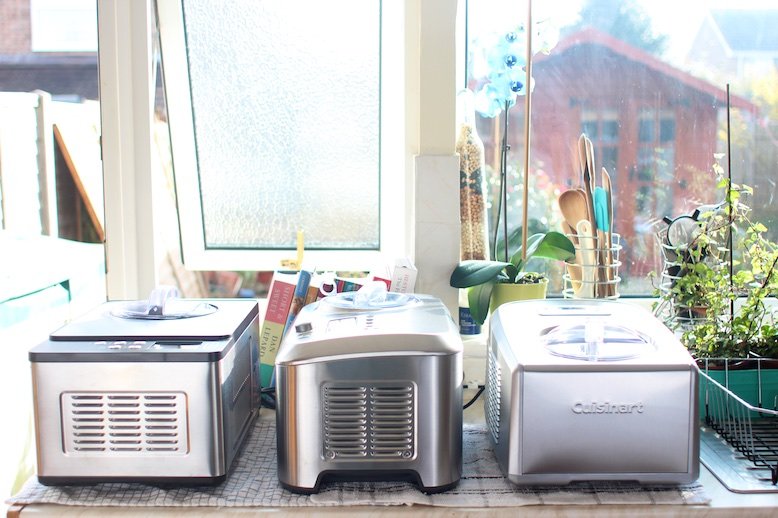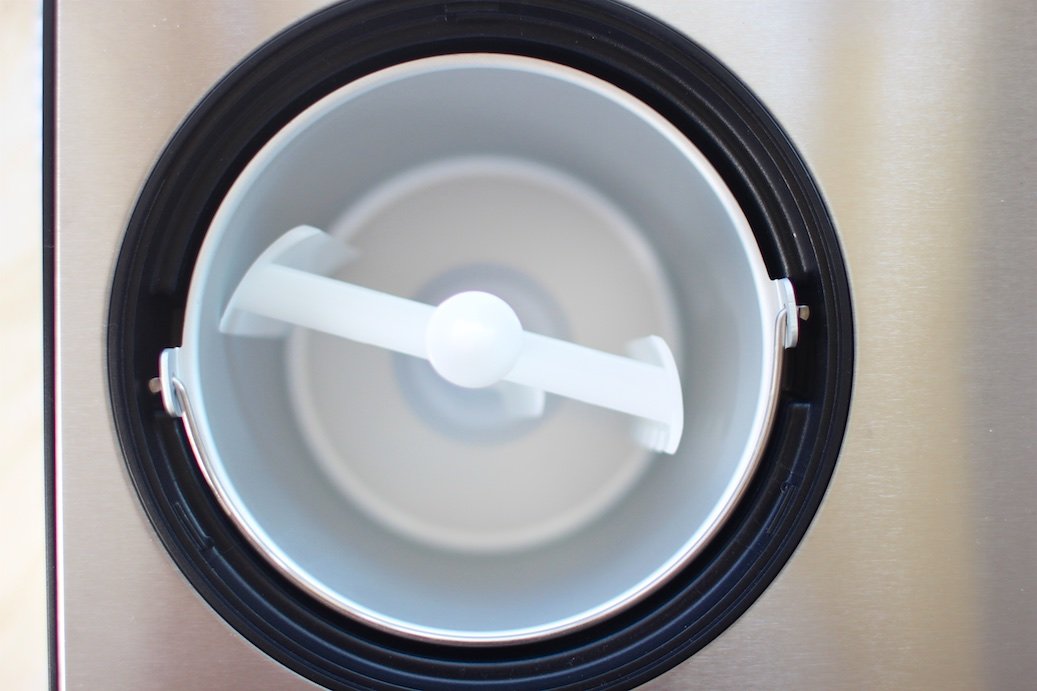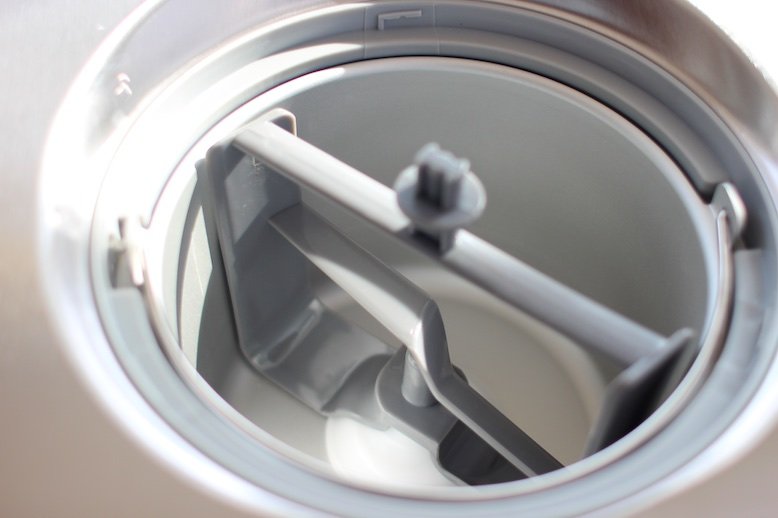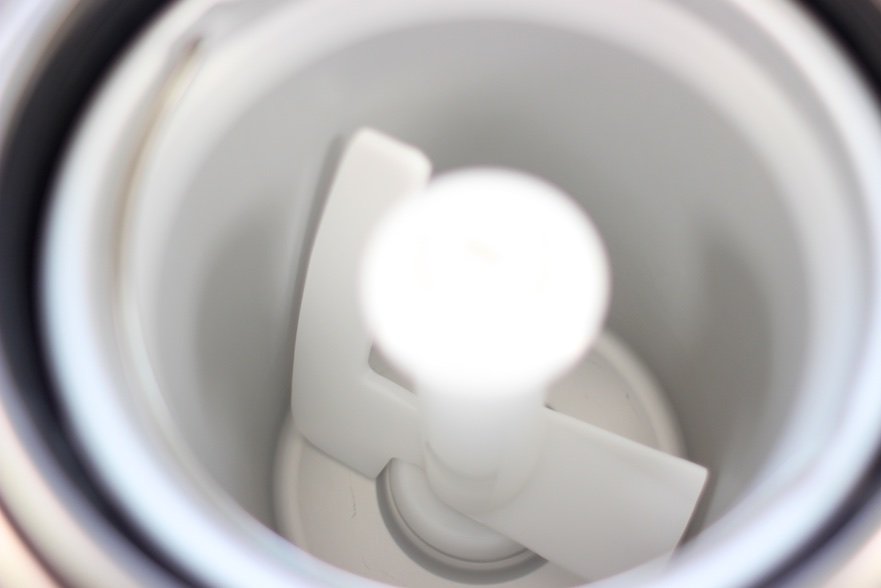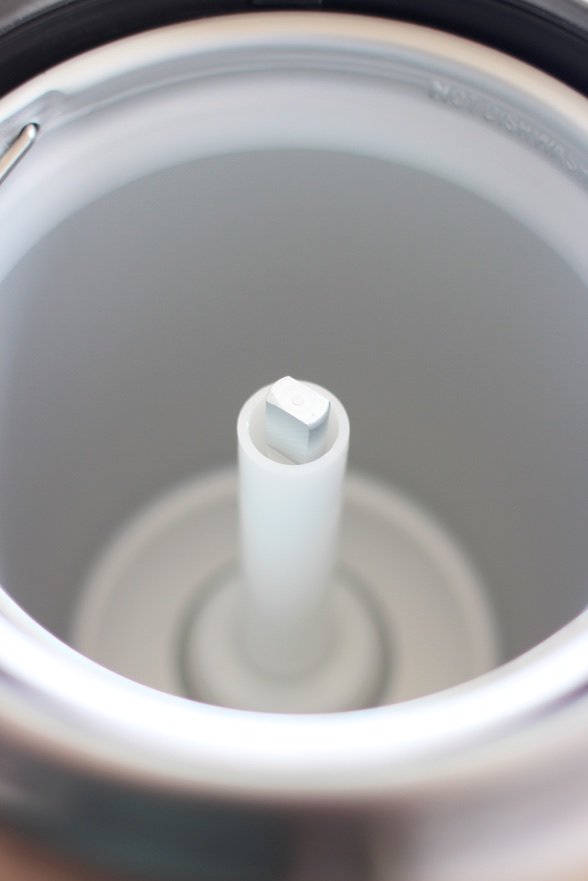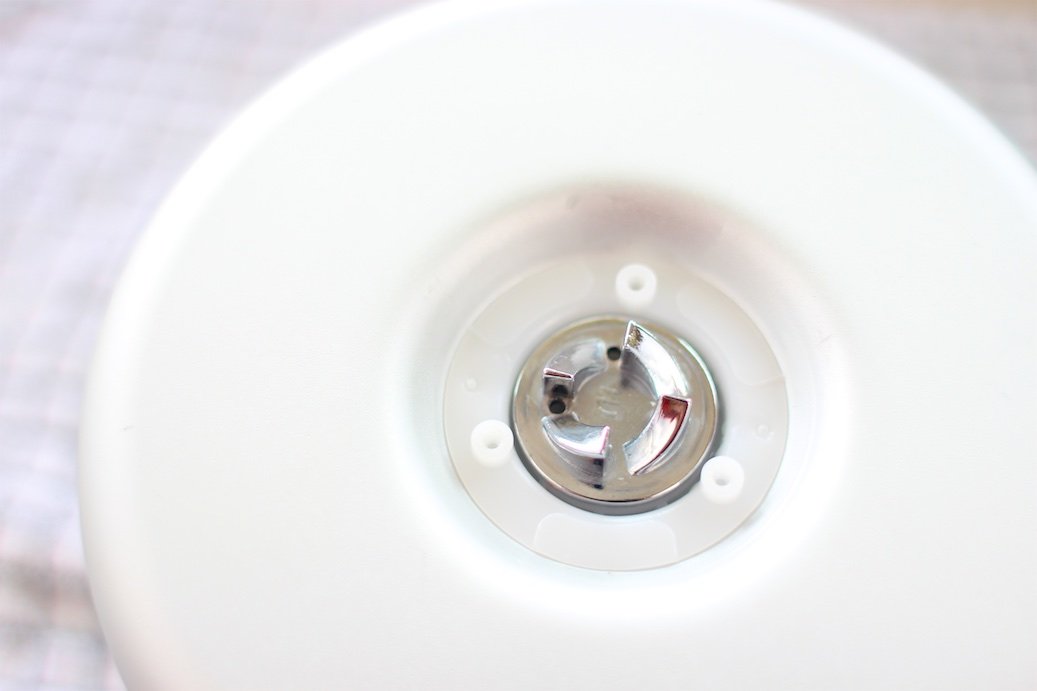Cuisinart ICE-100 vs Breville BCI600XL vs Whynter ICM-200LS
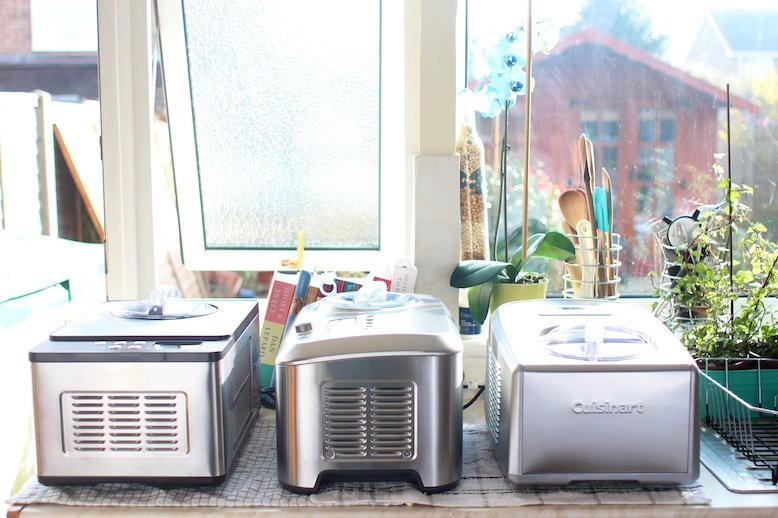 The Cuisinart ICE-100 Compressor Ice Cream and Gelato Maker, Breville BCI600XL Smart Scoop Ice Cream Maker, and the Whynter ICM-200LS Stainless Steel Ice Cream Maker, are three domestic ice cream makers with self-refrigerating compressors and are available from amazon*. All three make excellent ice cream that is extremely smooth, dense, and creamy, but each has its drawbacks. This will be a comprehensive and impartial comparison of, as well as my experience with, the three ice cream makers.I'M ALWAYS LOOKING FOR WAYS TO IMPROVE THIS BLOG. PLEASE DO GET IN TOUCH AND LET ME KNOW WHAT YOU DON'T LIKE ABOUT, OR WANT TO SEE INCLUDED IN, THIS REVIEW. RUBEN :)I'd also recommend having a look at the following machines:To view the top selling ice cream makers on amazon, please click here
The Cuisinart ICE-100 Compressor Ice Cream and Gelato Maker, Breville BCI600XL Smart Scoop Ice Cream Maker, and the Whynter ICM-200LS Stainless Steel Ice Cream Maker, are three domestic ice cream makers with self-refrigerating compressors and are available from amazon*. All three make excellent ice cream that is extremely smooth, dense, and creamy, but each has its drawbacks. This will be a comprehensive and impartial comparison of, as well as my experience with, the three ice cream makers.I'M ALWAYS LOOKING FOR WAYS TO IMPROVE THIS BLOG. PLEASE DO GET IN TOUCH AND LET ME KNOW WHAT YOU DON'T LIKE ABOUT, OR WANT TO SEE INCLUDED IN, THIS REVIEW. RUBEN :)I'd also recommend having a look at the following machines:To view the top selling ice cream makers on amazon, please click here
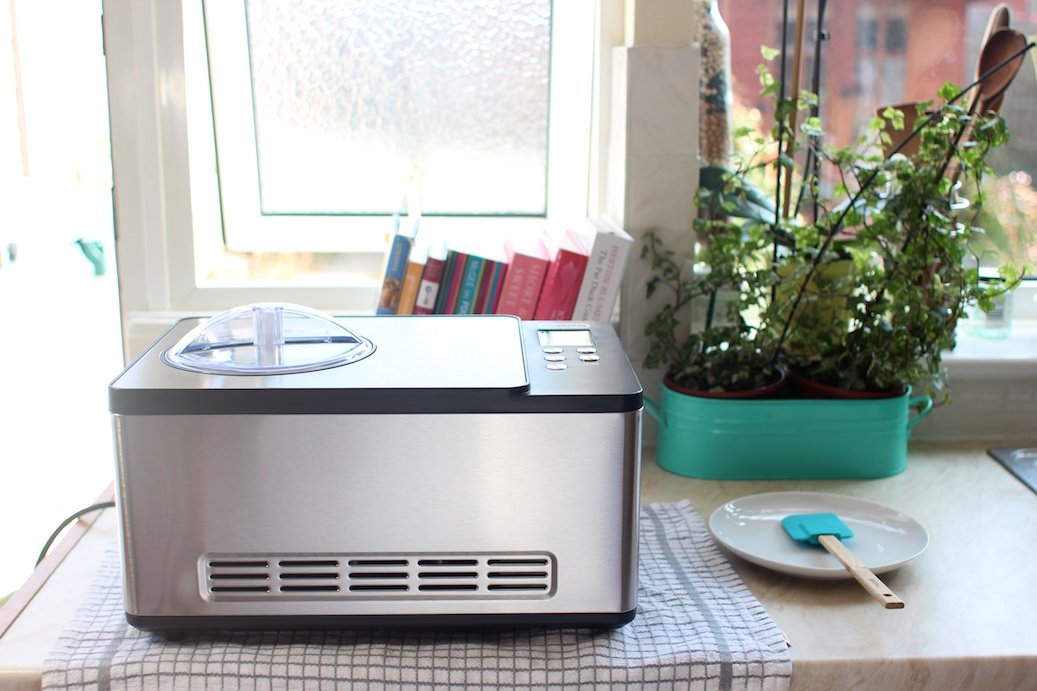
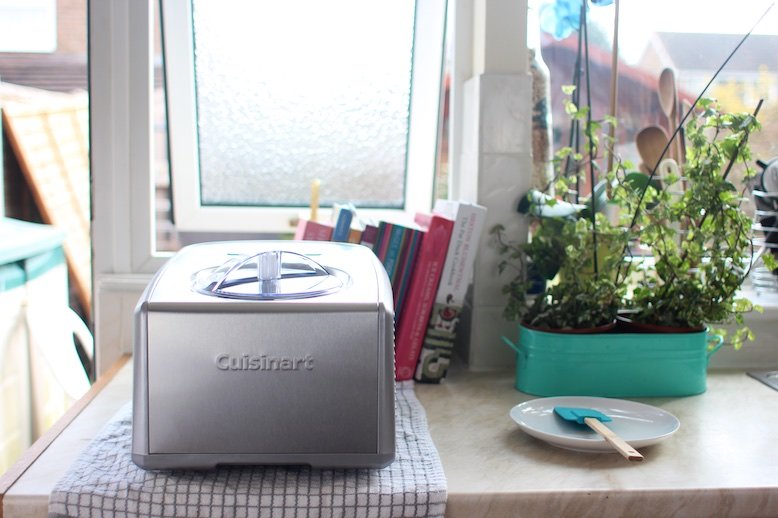
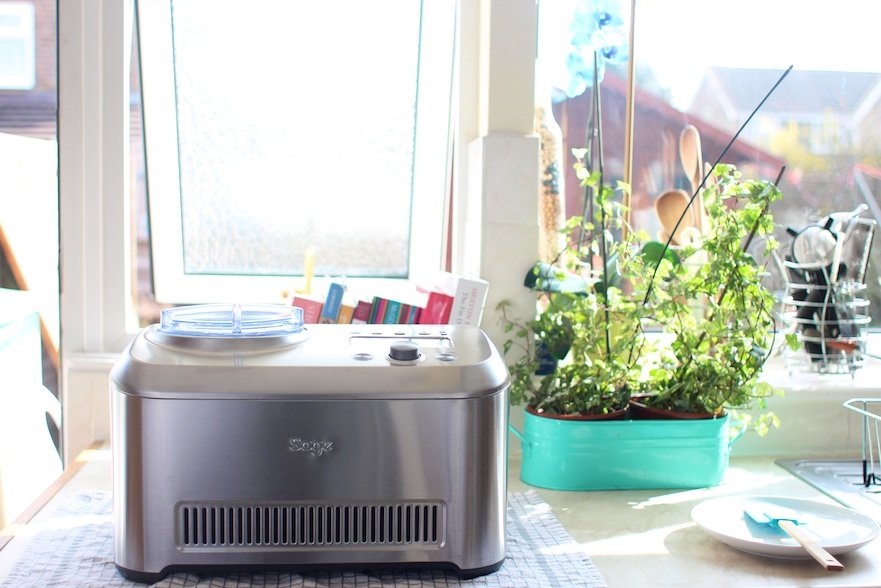 2. ICE CREAM MIX FORMULATION AND PROCESSINGTo test the three machines, 3 ice cream mixes were formulated to contain 54.9% total solids, 23.3% milk fat, 10.8% milk solids-not-fat (the lactose, proteins, minerals, water-soluble vitamins, enzymes, and some minor constituents), 16.3% sucrose, and 4.4% egg yolks. All mixes contained fresh cream, fresh milk, skimmed milk powder, sucrose, and egg yolk solids. All mixes were heated to 72°C (161°F), held at that temperature for 25 minutes, cooled, and aged overnight at 4°C (39°F). Mix composition was kept constant for all 3 mixes but mix volume varied from 700 ml (0.74 quarts) for the Breville BCI600XL Smart Scoop Ice Cream Maker and the Cuisinart ICE-100 Compressor Ice Cream and Gelato Maker, to 900 ml (0.95 quarts) for the Whynter ICM-200LS Stainless Steel Ice Cream Maker. Results from the 3 tests can be seen in section 5.2 of this review.3. OVERRUN
2. ICE CREAM MIX FORMULATION AND PROCESSINGTo test the three machines, 3 ice cream mixes were formulated to contain 54.9% total solids, 23.3% milk fat, 10.8% milk solids-not-fat (the lactose, proteins, minerals, water-soluble vitamins, enzymes, and some minor constituents), 16.3% sucrose, and 4.4% egg yolks. All mixes contained fresh cream, fresh milk, skimmed milk powder, sucrose, and egg yolk solids. All mixes were heated to 72°C (161°F), held at that temperature for 25 minutes, cooled, and aged overnight at 4°C (39°F). Mix composition was kept constant for all 3 mixes but mix volume varied from 700 ml (0.74 quarts) for the Breville BCI600XL Smart Scoop Ice Cream Maker and the Cuisinart ICE-100 Compressor Ice Cream and Gelato Maker, to 900 ml (0.95 quarts) for the Whynter ICM-200LS Stainless Steel Ice Cream Maker. Results from the 3 tests can be seen in section 5.2 of this review.3. OVERRUN
Overrun is the calculation of air that's incorporated into frozen desserts and is calculated as the percentage increase in volume of the mix that occurs as a result of the addition of air (Goff & Hartel, 2013). Overrun can range from as low as 20% to as high as 150% in ice cream and 20% to 60% in gelato, with low overrun generally associated with a premium product. Overrun influences the rate of melt down, with ice cream containing a high amount of air (high overrun) tending to melt slowly (Goff & Hartel, 2013), and ice crystal size, with smaller ice crystals observed in ice cream made at low overrun than in the same ice cream made at high overrun (Hartel, 1996; Sofjan & Hartel, 2003).
The Cuisinart ICE-100 Compressor Ice Cream and Gelato Maker comes with two dashers: one for gelato and one for ice cream. Both rotate at a low 26 revolutions per minute (rpm), relative to typical speeds of 100-200 rpm in commercial machines, resulting in about 20% overrun when using the ice cream dasher, and about 14% overrun when using the gelato dasher. The dasher on the Whynter ICM-200LS Stainless Steel Ice Cream Maker rotates at 25 rpm, resulting in overrun of about 8%. This is the lowest of the three machines and produces ice cream that is slightly heavier and denser than that produced by the Cuisinart ICE-100 and the Breville BCI600XL . The dasher on the Breville BCI600XL Smart Scoop Ice Maker rotates at 55 rpm, resulting in overrun of about 29%, the highest of the three machines. This produces ice cream that is slightly lighter and airer than that produced by the Cuisinart ICE-100 and the Whynter ICM-200LS.
4. MAXIMUM CAPACITY
The Whynter ICM-200LS Stainless Steel Ice Cream Maker comes with an impressive 2.1 quart removable aluminium freezer bowl, which has the largest maximum capacity of the three machines: 1400 ml (1.48 quarts) of mix, producing about 1600 ml (1.69 quarts) of frozen ice cream with about 14% overrun. However, although it's capable of freezing a 1400 ml batch, I've found that it produces the best textured ice cream when the mix volume does not exceed 1000 ml (1.06 quarts), which increases to about 1100 ml (1.16 quarts) with 10% overrun. Above 1000 ml, the ICM-200LS produces ice cream that is slightly coarse but of acceptable quality.
The Cuisinart ICE-100 Compressor Ice Cream and Gelato Maker comes with a 1.5 quart removable anodized aluminium freezer bowl. When using the gelato dasher, I've found the maximum capacity to be just under 700 ml ( 0.74 quarts) of mix, producing about 800 ml (0.85 quarts) of product with 14% overrun. Above 700 ml (0.74 quarts), a considerable amount of product starts to brush against the lid as it freezes. When using the ice cream dasher, I've found the optimum capacity to be 800 ml (0.85 quarts) of mix, producing about 1000 ml (1.06 quarts) of extremely smooth, dense, and creamy ice cream with 25% overrun. I've found that although the ICE-100 is capable of freezing 900 ml (0.95 quarts) of mix, producing about 1100 ml (1.16 quarts) of extremely smooth and creamy ice cream with 22% overrun, the ice cream just starts to brush against the lid as it freezes. When the batch is increased to 1000 ml (1.96 quarts), producing about 1250 ml (1.32 quarts) of ice cream with 25% overrun, a considerable amount of ice cream is pushed against the lid and texture deteriorates.
The Breville BCI600XL Smart Scoop Ice Cream Maker also comes with a 1.5 quart removable anodised aluminium freezer bowl. I've found that it has a slightly smaller optimum capacity of 700ml (0.74 quarts), which produces about 900 ml (0.95 quarts) of extremely smooth, dense, and creamy ice cream with about 30% overrun. When the mix is increased to 800 ml (0.85 quarts) and 900 ml (0.95 quarts), I find that although it's able to freeze both amounts, it produces ice cream that isn't quite as smooth and creamy as that made using a 700ml (0.74 quarts) mix.
5. ICE CRYSTALS IN ICE CREAM
Ice crystal size is a critical factor in the development of smooth texture (Donhowe et al., 1991) with smooth and creamy ice cream requiring the majority of ice crystals to be small, around 10 to 20 µm in size. If many crystals are larger than this, the ice cream will be perceived as being coarse or icy (Drewett & Hartel, 2007; Goff & Hartel, 2013). Ice crystal size is affected by the composition of the ice cream mix and by freezing, with the latter done in two stages: dynamic freezing, where the ice cream mix is frozen in an ice cream machine whilst being agitated to incorporate air, and static freezing, where the partially frozen ice cream is hardened without agitation in a freezer. Ice crystals form only during dynamic freezing and grow during static freezing.
In this post, we'll be looking at the key principles that underpin crystallisation, as well as the effect that the features on the three machines have on these principles. These will include the dasher, the self-refrigerating compressor, and the freezer bowl.
5.1. NUCLEATION
As the aqueous ice cream mix is added to the machine, the refrigerant removes enough heat to bring the mix below its freezing point. A layer of ice then freezes to the wall of the cold freezer bowl causing rapid nucleation, or the birth of small ice crystals (Hartel, 2001). These ice crystals are scraped off the wall by the rotating dasher and scraper blades and dispersed in the middle of the bowl where the mix is warmer and causes the ice crystals to grow and undergo recrystallisation (large crystals growing and fusing together) (Russell et al, 1999; Drewett & Hartel, 2007). Once the warmer mix in the middle of the bowl is cooled sufficiently, some of the ice crystals scraped from the cold ball wall begin to survive and grow.
It’s important to have a high rate of nucleation so as to create as many small ice crystals as possible (Hartel, 1996).
5.1.1. THE DASHER
Nucleation is affected by the rate of heat transfer from the mix to the cold freezer bowl, with a high rate of heat transfer promoting a high rate of nucleation (Hartel, 1996; Goff & Hartel, 2013). Because heat travels more slowly through ice than stainless steel or aluminium, ice building up on the freezer bowl wall acts as an insulator and lowers the rate of heat transfer. Goff & Hartel (2013) note that even a very thin layer of ice remaining on the bowl wall can cause a dramatic reduction in heat transfer. The rotating dasher and scraper blades help promote high heat transfer by scraping off the ice layer that forms on the side of the cold bowl wall. Keeping the scraper blades as close to the bowl wall as possible is therefore important because it prevents ice build up, thereby ensuring efficient heat transfer (Goff & Hartel, 2013).
A fundamental flaw common in all domestic machines I've tried is poorly designed dashers that leave a gap between the scraper blades and the bowl wall, resulting in a build up of ice on the bowl wall and inefficient heat transfer. It's only when you get to commercial machines that you find dashers with spring-loaded blades pushed firmly against the side of the bowl.
The Whynter ICM-200LS Stainless Steel Ice Cream Maker comes with a plastic dasher that has a plastic scraper blade and two mixing blades attached. When fitted onto the central pin in the freezer bowl, I've found that it leaves the smallest gap of the three machines between the scraper blade and the side of the bowl, and actually makes contact with the bottom right quarter of the bowl wall as it rotates, resulting in minimal ice build up.
The Breville BCI600XL Smart Scoop Ice Cream Maker comes with a plastic dasher that has two plastic scraper blades attached. I've found that when fitted onto the central pin in the freezer bowl, it leaves the largest gap of the three machines between the scraper blades and the side of the bowl, resulting in the build up of a relatively thick layer of ice on the bowl wall.
The Cuisinart ICE-100 Compressor Ice Cream and Gelato Maker comes with an ice cream and a gelato dasher. Both are made of plastic and both have two plastic scraper blades attached. When fitted onto the central pin in the freezer bowl, both leave just a slight gap between the main scraper blade and the side of the bowl, resulting in a relatively thin layer of ice build up on the bowl wall. As they rotate, the main scraper blades on both dashers actually make contact with just a small part of the bowl when the lid is off, but not when the lid is fixed in place.
5.1.2. THE SELF-REFRIGERATING COMPRESSOR
The freezer bowl temperature is another factor influencing the rate of nucleation and ice crystal size, with lower freezer bowl temperatures promoting higher rates of nucleation and smaller ice crystals. Drewett & Hartel (2007) found that decreasing the coolant temperatures at the freezer bowl wall caused higher ice crystal nucleation rates and reduced recrystallisation in the warmer bulk mix, which helped the ice crystals remain small. Similarly, Russell et al. (1999) found that as the freezer bowl temperature was lowered, the nucleation rate increased accordingly. Cook & Hartel (2011) simulated ice cream freezing in an ice cream machine by freezing ice cream mix in a thin layer on a microscope cold stage. The temperature at which ice cream mix was frozen on the cold stage varied from -7, -10, -15, and -20°C (19, 14, 5, and -4°F). They found that warmer freezing temperatures gave more elongated and slightly larger crystals with a wider size distribution.
To promote rapid nucleation, the temperature of the refrigerant should fall within the range of -23 to -29°C (-10 to -20°F) (Goff & Hartel, 2013), with the freezer bowl wall temperature estimated to be a few degrees warmer. I've found the compressor in the Whynter ICM-200LS Stainless Steel Ice Cream Maker to be the most powerful of the three: it's able to get the freezer bowl temperature down to an impressive -36°C (-32.8°F) when empty. The compressor in the Cuisinart ICE-100 Compressor Ice Cream and Gelato Maker is able to bring the freezer bowl wall temperature down to -30°C (-22°F) when empty, and the compressor in the Breville BCI600XL Smart Scoop Ice Cream Maker to -28°C (-18.4°F) when empty.
TIP #1 - LOW FREEZER BOWL WALL TEMPERATUREIt’s a good idea to leave the compressor running for about 15 minutes before you add the ice cream mix. This will ensure that the bowl is as cold as possible when the mix is added and help promote higher rates of nucleation and a shorter residence time.
5.2. RESIDENCE TIME
Residence time, that is the length of time the ice cream mix spends in the freezer bowl during dynamic freezing, has a significant effect on the final ice crystal size distribution, with longer residence times resulting in larger ice crystals (Russell et al., 1999; Goff & Hartel, 2013; Drewett & Hartel, 2007; Cook & Hartel, 2010). Russell et al. (1999) showed that residence time in the freezer bowl had a more important impact on final crystal size distribution than did the initial nucleation rate. A similar study by Drewett & Hartel (2007) also concluded that residence time has the greatest impact on final crystal size distribution, followed by draw temperature and dasher speed. This is because a longer residence time gives the ice crystals in the centre of the freezer bowl more time to recrystallise and grow larger (Russell et al., 1999; Drewett & Hartel, 2007).
A high rate of heat transfer and colder freezer bowl temperatures contribute significantly to shorter residence times. Lower freezer bowl wall temperatures can lower the bulk temperature of the ice cream faster, reducing residence time and improving the ice crystal size distribution (Russell et al., 1999; Drewett & Hartel, 2007). Commercial machines usually take between 8-10 minutes to freeze a large batch, ranging from 3 to 44 quarts, of ice cream. Below are the results from my residence times tests.
1. WHYNTER ICM-200LSMix volume: 900 ml (0.95 quarts).Frozen volume: About 950 ml (1.00 quarts).Overrun: About 8%.Residence time: 28 minutes.Draw temperature: -10°C (14°F).Texture: Really nice, smooth, and creamy. Quite heavy and not very airy.2. CUISINART ICE-100Mix volume: 700 ml (0.74 quarts).Frozen volume: About 840 ml (0.89 quarts).Overrun: About 20%.Residence time: 30 minutes.Draw temperature: -10°C (14°F).Texture: Really smooth and creamy.
3. BREVILLE BCI600XLMix volume: 700 ml (0.74 quarts).Frozen volume: About 900 ml (0.95 quarts).Overrun: About 29%.Residence time: 34 MINUTES.Draw temperature: -9°C (15.8°F).Texture: Nice, sweet, and creamy. Nice and airy and quite light.
Although residence time has a significant effect on the final ice crystal size distribution, a short residence time won’t guarantee smooth and creamy texture. The quality of homemade ice cream is, in my experience, more dependent on the recipe than on the machine you use. You might find it useful to have a look through my Vanilla Ice Cream Recipe to get an idea of mix composition.
5.3. DRAW TEMPERATURE
Draw temperature refers the temperature at which ice cream is removed from the freezer bowl and is usually -5 to -6°C (23 to 21.2°F) in commercial machines (Goff & Hartel, 2013). Draw temperature determines how much ice is frozen, with between 33 and 67% of the water in the mix being frozen during dynamic freezing and the hardening stage accounting for an additional 34-57% (Goff & Hartel, 2013). Caillet et al. (2003) showed that decreasing draw temperature resulted in more water being frozen and, consequently, increased ice crystal content. Similarly, Drewett & Hartel (2007) note that draw temperature significantly influences mean ice crystal size. They showed that ice crystals were larger at draw temperatures from -3 to -6°C (26.6 to 21.2°F). When the draw temperatures were colder than -6°C (21.2°F), the mean ice crystal size decreased.
To attain a low draw temperature, the freezer bowl temperature must be low to give rapid heat removal. Rapid heat removal allows for faster ice nucleation rates, which results in smaller ice crystals (Berger et al., 1972). I've found that the Whynter ICM-200LS Stainless Steel Ice Cream Maker and the Cuisinart ICE-100 Compressor Ice Cream and Gelato Maker have the lowest draw temperatures. The Whynter ICM-200LS has a draw temperature of -10°C (14°F) for mixes between 900 ml and 1200 ml (0.95 quarts and 1.27 quarts). With a larger 1400 ml (1.48 quarts), draw temperature drops to -9°C (15.8°F). The Cuisinart ICE-100 Compressor Ice Cream and Gelato Maker has a draw temperature of -10°C (14°F), and the Breville BCI600XL Smart Scoop Ice Cream a draw temperature of -9°C (15.8°F).
5.4. EXTRACTION TIME
To quickly review, we know that ice crystal size is critical for the development of smooth texture, with small ice crystals imparting smooth and creamy texture, whilst many large ice crystals impart coarse or sandy texture. A high rate of nucleation, a short residence time, and a low draw temperature play a significant role in promoting and maintaining small ice crystals and these three factors are governed by heat transfer and the freezer bowl temperature, which are, in turn, affected by the dasher and the self-refrigerating compressor.
At draw temperature of between -5 and -6°C (23 and 21.2°F), ice cream will have a consistency very similar to that of soft serve ice cream. Ice cream is usually served in its scoopbable state at around -12°C (10.4°F) and so requires further freezing, or hardening. This is known as the static freezing stage and its aim is to preserve the small ice crystals and air cells formed during dynamic freezing. The extraction time, that is the time it takes to empty the ice cream from the machine and get it into your freezer for hardening, is another factor that has a significant effect on ice crystal size.
As you extract your ice cream from the bowl, it spends time at room temperature. During this time at relatively warm room temperature, some of the ice melts from the large ice crystals and the crystals that were initially small melt completely. This is known as ripening and occurs when ice cream is held at elevated temperatures (Goff & Hartel, 2013). When you then get your ice cream into your freezer for hardening, the melted ice re-freezes onto the large ice crystals that survived. The result is that the total number of ice crystals is reduced and their size increases, resulting in coarse or sandy texture. Just holding your ice cream at room temperature, therefore, results in an increase in mean ice crystal size.
5.4.1. THE FREEZER BOWL
I've found that because of the space in the large 2.1 quart removable freezer bowl in the Whynter ICM-200LS, it's extremely quick and easy to extract the ice cream using a large wooden spoon. I haven't had any problems removing the dasher before commencing extraction, which I find speeds up extraction. I've found, however, that extraction takes considerably longer when freezing a large 1400 ml (1.48 quarts) mix. This is because the increased mix volume hardens and prevents the dasher from being removed, making it more difficult to quickly scoop out the ice cream. I've found the removable freezer bowl in Cuisinart ICE-100 equally as quick and easy to empty during the extraction stage. On the Breville BCI600XL, however, I've noticed that the plastic central pin on which the dasher sits rises about 10 cm (4 inches) from the centre of the bowl and only leaves a gap of 5 cm (2 inches) between it and the side of the bowl. This means that you have to use a smaller spoon, which I've found makes the extraction stage take slightly longer.
TIP #2 - QUICK EXTRACTION TIMEIt’s important that you extract your ice cream from the freezer bowl and get it into your freezer as quickly as possible. This is to minimise the time it spends at relatively warm room temperatures, where ice cream starts to melt, thereby limiting ice crystal growth during hardening.
5.5. THE STATIC FREEZING STAGE
When you extract your ice cream at between -6°C and -10°C (21.2°F and 14°F), significant changes to the ice crystals continue to take place until the temperature decreases to -18°C (-0.4°F), preferably -25°C to -30°C (-13 to -22°F) (Goff & Hartel, 2013) to halt these changes. Marshall and others (2003) note that during static freezing, ice crystals grow by about 30% to 40%. Donhowe (1993) showed that faster cooling of ice cream during hardening resulted in smaller mean ice crystal size.
TIP #3 - FAST COOLINGTo promote faster cooling of your ice cream during static freezing, it’s important to ensure that your freezer is set to its coldest temperature. If you have a super chill button, or something similar, it's a good idea to switch this on.
It's also a good idea to place your empty plastic container in the freezer a couple of hours before you start churning a batch. This will remove any heat stored in the container and will help prevent ice crystals that come in contact with the relatively warm plastic during the extraction stage from melting.
6. NOISE LEVEL
I've found all three machines very quiet during freezing and haven't had any issues with noise. The Whynter ICM-200LS is the quietest of the three during freezing, producing about 72 dB. The Breville BCI600XL is a close second, producing about 73 dB of noise during freezing, and the Cuisinart ICE-100 the loudest, producing about 85 dB of noise during freezing. I haven't found it a problem sitting in the same room with either of the three machines on.
7. ISSUES RAISED BY USERS
7.1. WHYNTER ICM-200LS STAINLESS STEEL ICE CREAM MAKER
Two pertinent issues that have been raised by users in their reviews on amazon are a squeaking noise and the dasher grinding to a halt before the ice cream has hardened sufficiently.
7.1.1. SQUEAKING NOISE
Several users have complained that their ICM-200LS makes a squeaking noise during freezing. The first time I froze a 900 ml (0.95 quarts) mix, I did find that the dasher made a squeaking noise as the mix hardened. This was due to the top of the dasher rubbing against the small plastic support tube in the lid. Surprisingly, I only encountered this noise the first time I froze a 900 ml (0.95 quarts) and haven't encountered it since. I presume this issue was due to an initial teething problem.
7.1.2. DASHER GRINDING TO A HALT
The second issue that has been raised by several users is the dasher clicking and stopping before the mix has had sufficient time to harden. Throughout my testing, I've noticed that the dasher does start to slip a minute or two before a draw temperature of -10°C (14°F) is reached. I've found this to be because the teeth on the gear that drives the dasher, and the teeth on the underside of the freezer bowl, are quite small and slip as the mix hardens. This problem is annoying but I've found that it doesn't prevent the mix from being sufficiently hardened nor a draw temperature of -10 (14°F) from being reached. I would, however, like to see bigger teeth on the driving gear and on the underside of the bowl on a future Whynter model to prevent this problem.
7.2. CUISINART ICE-100 COMPRESSOR ICE CREAM AND GELATO MAKER
An issue that's been raised by several users in their reviews on amazon is the build up of residue on the drive gear located on the underside of the freezer bowl. Users have noted that when the freezer bowl is soaked in a sink full of soapy water, some of the diluted ice cream mix gets in through the plastic seal on the underside of the bowl and through two small holes that have been drilled into the gear. Over time, this diluted ice cream mix hardens and causes an unpleasant smell.
After I froze a batch of ice cream, cleaned the bowl, and left it drying overnight, I turned the bowl upside down and unscrewed the three screws that hold in place the plastic seal around the gear. I noticed that there was some water that had got in through the seal and the two holes the previous night and and hadn't dried. This didn't get into the bowl itself, nor did it smell of dairy.
One user has noted that the gear on the underside of the freezer bowl looks very similar to that on a bread machine and that usually the instructions for bread machines warn to clean the inside of the bowl only and never to soak the entire bowl in water because it will damage the drive mechanism. When cleaning the bowl, I now ensure that my sink hole plug is open and use running hot water and a soapy sponge to first rinse off any left over ice cream mix inside the bowl. I then use running water to clean the outside and underside of the bowl instead of soaking it in the sink. I also regularly unscrew the the plastic seal on the underside of the bowl and pour boiling water over the seal and gear to sterilise them both. I make sure that both are dry before I screw the seal back on.
7.3. BREVILLE BCI600XL SMART SCOOP ICE CREAM MAKER
Several users have complained of a loud grinding noise, similar to gears grinding in a car's transmission. Throughout my testing, I haven't had any problems with grinding or squeaking noises, and have found the BCI600XL very quiet during freezing.
8. THE QUALITY OF THE ICE CREAM
All three machines produce excellent ice cream that is extremely smooth, dense, and creamy. The Breville BCI600XL incorporates slightly more air during freezing, resulting in ice cream that is slightly lighter and airer. The Whynter ICM-200LS incorporates the least amount of air, producing a nice dense ice cream. In a taste test, I found that ice cream produced by the Cuisinart ICE-100 was slightly smoother and creamier than that produced by both the Whynter ICM-200LS and the Breville BCI500XL, with the Whynter ICM-200LS a close second, and the Breville BCI600XL third for overall texture.
9. FINAL THOUGHTS
The [amazon text=Whynter ICM-200LS Ice Cream Maker&asin=B00N63J432]* has the largest capacity freezer bowl of the three with a maximum capacity of 1400 ml (1.48 quarts) of mix, producing about 1600 ml (1.69 quarts) of frozen ice cream with about 14% overrun, and an optimum capacity of between 900 ml and 1000 ml (0.95 quarts to 1.06 quarts) of ice cream mix, producing about 950 ml (1.00 quarts) and 1100 ml (1.16 quarts) of ice cream respectively with about 10% overrun. It also has the most powerful compressor, producing the lowest freezer bowl wall temperature of -36°C (-32.8°F) when empty, the smallest gap between the scraper blades to the freezer bowl wall, and the shortest residence time. It does, however, suffer from a dasher that slips and stops as the ice cream mix hardens. Because of its relatively large freezer bowl capacity, it might be a good choice for people who want to produce large quantities of ice cream.
The [amazon text=Cuisinart ICE-100 Ice Cream and Gelato Maker&asin=B006UKLUFS&asin[uk]=B00ARETWDK&asin[de]=B00ARETWDK&asin[fr]=B00EDOVBP2&asin[es]=B00EDOVBP2&asin[it]=B00ARETWDK&asin[ca]=B006UKLUFS]* comes with an ice cream and a gelato dasher, the latter incorporating slightly less air into the mix. It has a smaller 1.5 quart anodized aluminium freezer bowl with a maximum capacity of 900 ml (0.95 quarts) of mix, producing about 1100 ml (1.16 quarts) of ice cream with 22% overrun, and an optimum capacity of 800 ml (0.85 quarts) of mix, producing about 1000 ml (1.06 quarts) of extremely smooth, dense, and creamy ice cream with 25% overrun. When using the gelato dasher, the maximum capacity drops to just under 700 ml ( 0.74 quarts) of mix, producing about 800 ml (0.85 quarts) of product with 14% overrun. It does, however, require careful cleaning of the freezer bowl to prevent the build up of residue on the drive gear located on the underside of the freezer bowl.
The [amazon text=Breville BCI600XL Smart Scoop Ice Cream Maker&asin=B009OZ62IG&asin[ca]=B009OZ62IG&asin[uk]=B00CI32S0W&asin[de]=B00HFQDG5I&]* also comes with a 1.5 quart removable anodised aluminium freezer bowl. It has a maximum capacity of 900 ml (0.95 quarts) of mix, producing about 1000 ml (1.06 quarts) of ice cream with about 11% overrun, and a slightly smaller optimum capacity of 700 ml (0.74 quarts), producing about 900 ml (0.95 quarts) of extremely smooth, dense, and creamy ice cream with about 30% overrun. When the mix is increased above 700 ml (0.74 quarts), I find that although it's able to freeze both amounts, texture slightly deteriorates. At 55 rpm, the dasher incorporates the most air during freezing, producing ice cream that is slightly lighter and airer than both the Cuisinart ICE-100 and Whynter ICM-200LS.
I've found that all three machines make excellent ice cream that is extremely smooth and creamy. In a taste test, I found that the Cuisinart ICE-100 produced ice cream that was just slightly smoother than that produced by both the Whynter ICM-200LS and the Breville BCI600XL. Because of the quality of ice cream it produces, my preference would be for the Cuisinart ICE-100 Ice Cream and Gelato Maker.
10. COMPARABLE MACHINES
The [amazon text=Lello 4080 Musso Lussino 1.5-Quart Ice Cream Maker&asin=B00004RDF0&asin[ca]=B00004RDF0&asin[uk]=B00004RDF0&asin[de]=B00004RDF0&asin[it]=B00004RDF0&asin[es]=B00004RDF0&asin[fr]=B00004RDF0]* has a an optimum capacity of 600 ml (0.63 quarts), a short residence time of 16 minutes, and makes exceptional ice cream that is extremely smooth, dense, and creamy. The [amazon text=Lello Musso Pola 5030 Dessert Maker&asin=B000FIWZLO&asin[ca]=B000FIWZLO&asin[uk]=B004S7BHE4&asin[de]=B004S7BHE4&asin[fr]=B004S7BHE4&asin[it]=B004S7BHE4]* has an impressive 1300ml (1.37 quarts) maximum capacity, makes exceptional ice cream, and at 13 minutes has the shortest residence time of any domestic machine I've tried.
I hope that helps. I’d be happy to answer any questions so do get in touch and say hi! All the best, Ruben :)
Transparency is key. On that note, I haven't been paid to write this review, nor was I given this machine for free. I paid for this bad boy with my own money and have written this review in my own time. If there is a * after a link, it means that I will earn a payment if you go through it and make a purchase on amazon. This doesn't increase the cost of what you purchase, nor do these links influence what I write, ever.
References
Berger, K. G,, Bullimore, B. K., White, G. W., & Wright, W. B., (1972). The structure of ice cream – Part 1. Dairy Industries, 37(8), 419-425.
Caillet, A., Cogne, C., Andrieu, J., Laurent, P., Rivoire, A., 2003. Characterization of ice cream structure by direct optical microscopy. Influence of freezing parameters. Lebensm Wiss U Technol. 36:743–749.
Cook, K. L. K., & Hartel, R. W., 2010. Mechanisms of Ice Crystallisation in Ice Cream Production. Comprehensive Reviews in Food Science and Food Safety. 9(2).
Cook, K. L. K., and Hartel, R. W., 2011. Effect of freezing temperature and warming rate on dendrite break-up when freezing ice cream mix. International Dairy Journal. 21(6).
Donhowe, D. P., Hartel R. W., and Bradley R.L., 1991. Determination of ice crystal size distributions in frozen desserts. Journal of Dairy Science. 74.
Donhowe, D. P. (1993) Ice Recrystallization in Ice Cream and Ice Milk. PhD thesis, University of Wisconsm-Madison.
Drewett, E. M., & Hartel, R. W., 2007. Ice crystallisation in a scraped surface freezer. Journal of Food Engineering. 78(3).
Goff, H. D., and Hartel R. W., 2013. Ice Cream. Seventh Edition. New York Springer.
Hartel, R. W., 1996. Ice crystallisation during the manufacture of ice cream. Trends in Food Science & Technology. 7(10).
Hartel, R. W., 2001. Crystallisation in foods. Gaithersburg, MD: Aspen Publishers.
Marshall, R. T., Goff, H. D., and Hartel R. W., 2003. Ice cream (6th ed). New York: Kluwer Academic/Plenum Publishers.
Russell, A. B., Cheney, P. E., & Wantling, S. D., 1999. Influence of freezing conditions on ice crystallisation in ice cream. Journal of Food Engineering. 29.
Sofjan, R., P., and Hartel, R. W., 2003. Effects of overrun on structural and physical characteristics of ice cream.International Dairy Journal. 14, 255-262.

